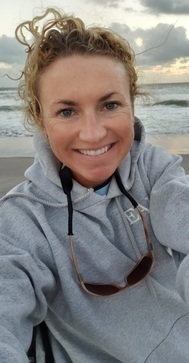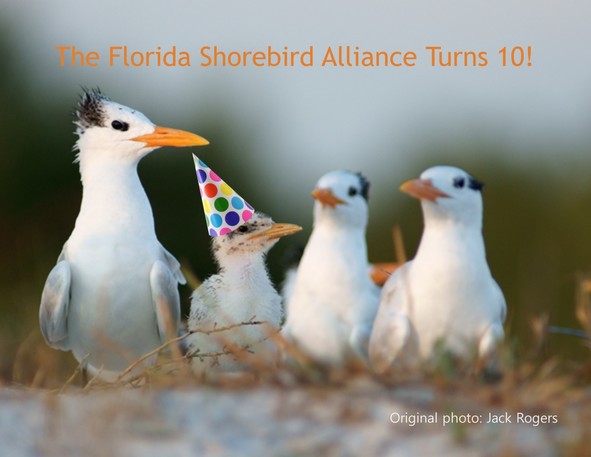Bird Stewardship Training:
April 3rd, 6pm: Outback Key stewardship training, Q&A
Boyd Hill Nature Preserve; hosted by St. Pete Audubon
April 12th, 2pm: 3 Rooker Island stewardship training
Honeymoon Island State Park nature center; hosted by Audubon Florida
April 13th, 9am: Lido Key stewardship training
Holiday Inn Sarasota - Lido Beach; hosted by Audubon Florida
May 11th, 9am: Pinellas County Municipal Beach stewardship training
(covers Sand Key, Clearwater Point, Indian Shores, St. Pete Beach)
Indian Shores City Hall, 4th floor; hosted by Audubon Florida
Events:
April 9: Corkscrew Swamp Sanctuary Lunch & Learn: Shorebirds
April 10-12: Florida Wildlife Society Conference
April 11: Shorebird Walk at Matanzas Inlet
April 15: A Tern for the Better: Shorebird Conservation in Northeast Florida
April 24-28: Florida's Birding & Photo Fest
April 27: Shorebirds of Florida's West Coast
Reminder
April 15 - 21 is the April count window for the Breeding Bird Protocol. Whenever possible, weekly surveys are preferred for routes with active nesting; it helps capture information about peak counts.

Partner Spotlight: Niki Desjardin of the Treasure Coast Shorebird Partnership
Niki Desjardin of the Treasure Coast Shorebird Partnership has dedicated her life to conserving coastal wildlife. She is a Senior Project Manager for Ecological Associates Inc. (EAI) where she oversees hiring, training and coordinating all field staff for sea turtle and shorebird monitoring projects from Indian River County to Palm Beach County. Beginning this spring, she is also the new coordinator for the Treasure Coast Shorebird Partnership.
Niki has had a life-long love of marine and coastal wildlife. She received her B.S. in Biology from the University of Richmond and her M.S. in Marine Biology from Florida Atlantic University. Although originally from Shrewsbury, Massachusetts, she moved to Florida to pursue a career as a marine biologist. Niki initially studied and worked with leatherback sea turtles, conducting nesting surveys and supporting rehabilitation efforts.
Her dedication to sea turtles led Niki to EAI where she's spent the last 14 years directing projects related to coastal construction and beach nourishment. This work opened the door to shorebirds and now she thoroughly enjoys checking for nesting birds every day during the breeding season. In her years at EAI, Niki is most proud of helping develop coastal lighting conditions that are more wildlife-friendly and reduce sky glow
As a coastal project manager, Niki has seen considerable overlap between the conservation needs of sea turtles and shorebirds. She uses this experience and expertise to educate beach-goers about our impact on coastal wildlife. She is especially interested in educating people about the impacts that lighting, beach holes, and monofilament have on sea turtles and shorebirds.
When not working for the benefit of coast wildlife, Niki is passionate about running. She is currently training for her third marathon, the famous Boston Marathon. We’re excited to have someone as passionate as Niki leading the Treasure Coast Shorebird Partnership. Thank you for your dedication to coastal wildlife and good luck in Boston!
|
 This year the Florida Shorebird Alliance (FSA) is celebrating 10 years of partnership success! The FSA is a statewide network of local partnerships that coordinate on-the-ground conservation of shorebirds and seabirds (shorebirds) across the state. The FSA is unique among Florida conservation initiatives in the degree to which we harness a broad array of individual and institutional efforts to move the conservation needle for these species.
Most shorebirds in Florida nest directly on Florida’s popular beaches, making them susceptible to a myriad of familiar challenges (habitat loss, chronic disturbance, predators). Surveys from the 1990’s indicated declining shorebird populations in Florida and highlighted their conservation plight. By the early 2000’s, local, informal collaborative efforts were working to conserve these species. By 2006, these collaborations were coalescing into more formal partnerships but generally operated in isolation from one another. To catalyze this conservation momentum, FWC officially launched the FSA in 2009, creating a dedicated coordinator position to help galvanize efforts across the state.
There are now 12 FSA partnerships whose geographic ranges span from single county coordination such as the Volusia County Shorebird Partnership, to regional organizations such as the Florida Shorebird Panhandle Working Group. While we are diverse and include concerned citizens, professional biologists and land managers, non-government organizations, businesses, and government agencies, we share the same overall vision of supporting viable shorebird and seabird populations that are managed in balance with human activities.
Each breeding season, our partners undertake a coordinated, multi-faceted approach to support management-dependent shorebirds and seabirds. In 2018, almost 200 individual partners monitored more than 330 beach routes covering nearly 900 miles of beach-nesting habitat. Additionally, more than 100 monitors surveyed more than 400 rooftops across the state. In the same year, 150 acres of nesting habitat were posted with rope and sign, protecting 4,738 total nests.
In areas where posting alone is not enough to reduce disturbance at nesting areas, a special group of volunteers mediate successful beach nesting through outreach and education. Bird Stewards work to minimize disturbance to shorebirds by informing beach-goers about the birds and their conservation challenges. In 2018, 750 volunteers spent over 8,000 hours stewarding 283 sites, including both beaches and rooftops.
In 2016, our partners set an ambitious goal of increasing populations of five focal species by 10% in 10 years. Well-defined actions, strategies, and funding mechanisms are outlined in Florida’s Imperiled Beach-nesting Bird Plan. During the next 10 years of shorebird conservation, we will continue to adaptively manage Florida’s unique shorebird and seabird populations in a way that conserves habitat and increases viable populations.
Thank You to each and every partner for your priceless contributions to the previous 10 years of shorebird conservation. We look forward to working together during another decade of success! To keep up with the latest FSA news, subscribe to the Wrack Line Newsletter and join the FSA Facebook Group.

Are you a shorebird breeding bird surveyor but missed the Breeding Bird Protocol (BBP) and Florida Shorebird Database (FSD) webinars? Fear not, the webinars are now on YouTube and the updated BBP is on the FSD website. View the webinars here:
New FSA Surveyor Webinar
Returning FSA Surveyor Webinar
FSA Rooftop Monitors Webinar
|